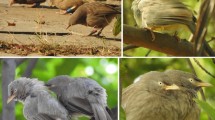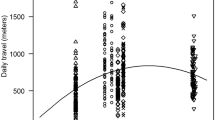Summary
I studied the foraging behaviour of adults in three different-sized groups of yellow baboons (Papio cynocephalus) at Amboseli National Park in Kenya to assess the relationship between group size and foraging efficiency in this species. Study groups ranged in size from 8 to 44 members; within each group, I collected feeding data for the dominant adult male, the highest ranking pregnant female, and the highest ranking female with a young infant. There were no significant differences between groups during the study in either the mean estimated energy value of the food ingested per day for each individual (385±27 kJ kg-1 day-1) or in the estimated energy expended to obtain that food (114±3 kJ kg-1 day-1). Mean foraging efficiency ratios, which reflect net energy gain per unit of foraging time, also did not vary as a function of the size of the group in which the baboons were living. There was substantial variation between days in the efficiency ratios of all animals; this was the result of large differences in energy intake rather than in the energy expended during foraging itself. The members of the smallest group spent on the average only one-half as much time feeding each day as did individuals in the two larger groups. However, they obtained almost as much energy while foraging, primarily because their rate of food intake while actually eating tended to be higher than the rate in the other groups. The baboons in the small group were observed closer to trees that they could climb to escape ground predators, and they also were more likely to sit in locations elevated above the ground while resting. Such differences would be expected if the members of the small group were less able to detect approaching predators than individuals that lived in the larger groups. The results of this study suggest that predator detection or avoidance, rather than increased foraging efficiency, may be the primary benefit of living in larger groups in this population.
Similar content being viewed by others

References
Alexander RD (1974) The evolution of social bahavior. Annu Rev Ecol Syst 5:325–384
Altmann J (1974) Observational study of behavior: sampling methods. Behaviour 49:227–267
Altmann J (1980) Baboon mothers and infants. Harvard University Press, Cambridge
Altmann SA (1974) Baboons, space, time and energy. Am Zool 14:221–248
Altmann SA (1979) Baboon progressions: order or chaos? A study of one-dimensional group geometry. Anim Behav 27:46–80
Altmann SA (in press) Foraging and nutrition in weanling baboons. University of Chicago Press, Chicago
Altmann SA, Altmann J (1970) Baboon ecology: African field research. University of Chicago Press, Chicago
Berger J (1978) Group size, foraging and antipredator ploys: an analysis of bighorn sheep decisions. Behav Ecol Sociobiol 4:91–99
Bertram BCR (1978) Living in groups: predators and prey. In: Krebs JR, Davies NB Behavioral ecology. Blackwell, Oxford, pp 64–96
Bramblett CA (1969) Non-metric skeletal age changes in the Drajani baboon. Am J Phys Anthropol 30:161–172
Caraco T (1979) Time budgeting and group size: a theory. Ecology 60:611–617
Clutton-Brock TH (1977) Primate ecology. Academic, London
Clutton-Brock TH, Harvey PH (1977) Primate ecology and social organization. J Zool Lond 183:1–39
Coelho AM, Quick LB, Bramblett SS (1976) Resource availability and population density in primates: a sociobioenergetic analysis of the energy budgets of Guatemalan howler and spider monkeys. Primates 17:63–80
Crampton EW, Harris LE (1979) Applied animal nutrition. Freeman, San Francisco
Crook JH (1970) The socio-ecology of primates. In: Crook JH (ed) Social behavior in birds and mamals. Academic Press, New York, pp 102–106
Crook JH (1972) Sexual selection, dimorphism, and social organization in the primates. In: Campbell BG (ed) Sexual selection and the descent of man, 1871–1971. Aldine, Chicago, pp 231–281
DeVore I, Hall K (1965) Baboon ecology. In: DeVore I (ed) Primate behavior: field studies of monkeys and apes. Holt, Rinehart and Winston, New York, pp 20–52
Eisenberg JF, Muckenhirn NA, Rudran R (1972) The relation between ecology and social structure in primates. Science 176:863–874
Hausfater G (1975) Dominance and reproduction in baboons: a quantitative analysis. Contrib Primatol 7
Hausfater G (1976) Predatory behavior of yellow baboons. Behaviour 56:44–68
Iwamoto T (1979) Feeding ecology. In: Kawai M (ed) Ecological and sociological studies of gelada baboons. Contrib Primatol 16:279–330
Jolly A (1972) The evolution of primate behavior. Macmillan, New York
Keppel G (1973) Design and analysis. A researcher's handbook. Prentice-Hall, Englewood Cliffs
Kleiber M (1961) The fire of life. Wiley, New York
Knapka JJ, Morin ML (1979) Open formula natural ingredient diets for non-human primates. In: Kayes KC (ed) Primates in nutritional rescarch. Academic, New York, pp 121–138
Krebs J, MacRoberts M, Cullen J (1972) Flocking and feeding in the great tit Parus major: an experimental study. Ibis 114:507–530
Lazarus J (1979) The early warning function of flocking in birds: an experimental study with captive Quelea. Anim Behav 27:855–865
Leung WTL (1968) Food composition table for use in Africa. United States Department of Ariculture, Washington
Nagy KA, Milton K (1979) Energy metabolism and food consumption by wild howler monkeys (Alouatta palliata). Ecology 60:475–480
Pitcher TJ, Magurran AE, Winfield IJ (1982) Fish in larger shoals find food faster. Behav Ecol Sociobiol 10:149–151
Post DG (1981) Activity patterns of yellow baboons (Papio cynocephalus) in the Amboseli National Park, Kenya. Anim Behav 29:357–374
Post DG, Hausfater G, McCuskey S (1980) Feeding behaviour of yellow baboons (Papio cynocephalus): relationship to age, gender, and dominance rank. Folia Primatol 37:170–195
Powell GUN (1974) Experimental analysis of the social value of flocking by starlings (Sturnus volgaris) in relation to predation and foraging. Anim Behav 22:501–508
Pulliam HR, Caraco T (1984) Living in groups: is there an optimal group size? In: Krebs JR, Davies NB (eds) Behavioral ecology. Blackwell, Oxford, pp 123–147
Pulliam HR, Millikan GC (1982) Social organization in the non-reproductive season. Avian Biol 6:169–197
Rottenberry JT (1980) Dietary relationship among shrubsteppe passerine birds: competition or opportunism in a variable environment? Ecol Monogr 50:93–110
Rowell T (1979) How would we know if social organization were not adaptive? In: Bernstein IS, Smith EO (eds) Primate ecology and human origins: ecological influences on social organization. Garland, New York, pp 1–22
SAS Institute (1979) SAS User Guide. Helwig JT, Council KA (eds). SAS Institute, Cary, NC
Schaik CP van, Noordwijk MA van, Boer JR de, Tonkelaar I den (1983) The effect of group size on time budgets and social behavior in wild long-tailed macaques (Macaca fascicularis). Behav Ecol Sociobiol 13:173–181
Schaik CP van (1983) Why are diurnal primates living in groups?. Behaviour 87:120–144
Schoener TW (1971) Theory of feeding stategies. Annu Rev Ecol Syst 2:369–404
Stander JM (1970) Diversity and similarity of benthic fauna off Oregon. Thesis. Oregon State University, Corvallis
Stelzner JK, Strier K (1981) Hyena predation on an adult male baboon. Mammalia 45:259–260
Sullivan KA (1984) The advantages of social foraging in downy woodpeckers. Anim Behav 32:16–22
Terborgh J (1983) Five new world primates: a study in comportative ecology. Princeton University Press, Princeton, NJ
Treisman M (1975) Predation and the evolution of gregariousness. II. An economic model for predator-prey interactions. Anim Behav 23:801–825
Thompson WA, Vertinsky I, Krebs JR (1974) The survival value of flocking in birds: a simulation model. J Anim Ecol 43:785–820
Travis J (1982) A method for the statistical analysis of time-energy budgets. Ecology 62:19–25
Tucker VA (1979) Energetic cost of locomotion in animals. J Comp Biochem Physiol 34:841–846
Waser PM (1977) Feeding, ranging, and group size in the mangabey, Cercocebus albigena. In: Clutton-Brock TE (ed) Primate ecology, Academic, London, pp 183–222
Western D, Praet C van (1973) Cyclical changes in the habitat and climate of an east African ecosystem. Nature 241:104–106
Wrangham RW (1980) An ecological model of female-bonded primate groups. Behaviour 75:262–300
Zar JH (1974) Biostatistical analysis. Prentice-Hall, Englewood Cliffs
Author information
Authors and Affiliations
Rights and permissions
About this article
Cite this article
Stacey, P.B. Group size and foraging efficiency in yellow baboons. Behav Ecol Sociobiol 18, 175–187 (1986). https://doi.org/10.1007/BF00290821
Received:
Accepted:
Issue Date:
DOI: https://doi.org/10.1007/BF00290821



